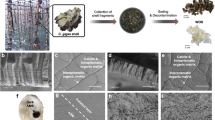Abstract
ONE of us1 has recently isolated oocyan—the blue-green pigment of the shells of many birds' eggs—and characterised it as an ether-soluble pyrrol pigment closely related to the bile pigments. We have now found a second example of this class of substances in the green pigment of the dog's placenta, the properties of which are very similar to those of oocyan. This pigment was examined in 1871 by Etti,2 and considered to be biliverdin ; it is formed by the transformation of the blood-pigment in the extravasates of the dog's placenta.3 While the methoxyl content of the ester of oocyan indicated a molecule with only three pyrrol nuclei, the analysis and methoxyl content of the methyl ester of uteroverdin (as we will call the substance) show that we are dealing with a substance with four pyrrol nuclei. From its composition (C35H38–42N4O6) it appears that it is the dimethyl ester of a dehydrobilirubin or dehydromesobilirubin. The values for C, H, and N (not, however, the methoxyl content) of the ester of oocyan agree also with the formula C37,H42N4O8 ; that is to say, with that of the trimethyl ester of a substance which differs from uteroverdin only in possessing one more carboxyl group. A further investigation of oocyan by one of us (R. L.) is in progress.
This is a preview of subscription content, access via your institution
Access options
Subscribe to this journal
Receive 51 print issues and online access
$199.00 per year
only $3.90 per issue
Buy this article
- Purchase on Springer Link
- Instant access to full article PDF
Prices may be subject to local taxes which are calculated during checkout
Similar content being viewed by others
References
R. Lemberg, Liebigs Ann., 488, 74; 1931.
Etti, Malys Jahresberichte, p. 233; 1871 ; p. 287; 1872.
On the histological findings, see B. Schick, Zeit. Für Kinderheilkunde, 28, 231; 1921. N. Lieberkühn and H. Strahl, Arch. Fü Anat. und Physiol., p. 196; 1889.
H. Fischer and E. Adler, Zeit. Für physiol. Chem., 200, 209; 1931.
Author information
Authors and Affiliations
Rights and permissions
About this article
Cite this article
LEMBERG, B., BARCROFT, J. & KEILIN, D. Uteroverdin. Nature 128, 967–968 (1931). https://doi.org/10.1038/128967c0
Issue Date:
DOI: https://doi.org/10.1038/128967c0
This article is cited by
-
�berf�hrung der Rotalgenfarbstoffe in Mesobilirubin und Mesodehydrobilirubin
Die Naturwissenschaften (1933)
Comments
By submitting a comment you agree to abide by our Terms and Community Guidelines. If you find something abusive or that does not comply with our terms or guidelines please flag it as inappropriate.



